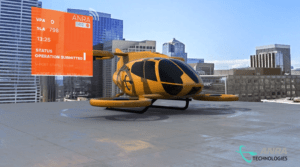 Can Urban Air Mobility thrive without better infrastructure? In this Op-Ed, Brent Klavon discusses the urgent need for vertiport automation.
Can Urban Air Mobility thrive without better infrastructure? In this Op-Ed, Brent Klavon discusses the urgent need for vertiport automation.
The following guest post is an original op-ed from Brent Klavon, Vice President at ANRA Technologies. DRONELIFE neither makes nor accepts payment for guest posts.
Are Vertiports the Weakest Link in the UAM Ecosystem?
The news is filled with stories about flying taxis and how these pilotless aircraft are ushering in a new era of aviation. A recent study commissioned by NASA defines this concept as “…the future of aviation includes Urban Air Mobility (UAM) — a concept involving aircraft, air traffic management, and new infrastructure.”
The UAM ecosystem includes electrically powered aircraft that transport people and cargo from node to node, where each node represents a vertiport or airport. Highly functional and performing vertiports are critical to achieving the commercial success for the UAM industry. However, with the exception of NASA sponsored efforts and the recent international standards committee (ASTM), the focus has largely been on the physical requirements for vertiports and not on its corresponding digital architecture, potentially creating a bottleneck at the nodes that are meant to facilitate movement, not hinder it. Is this lack of attention on digitizing ventiports creating a weak link for UAM in reaching its vast potential?
To fully realize the market potential for UAM, higher levels of aircraft autonomy will be necessary and the systems that support that automation must keep pace. NASA indicates that vertiports will require improvements for collaborative decision making, scheduling, airspace management, demand capacity balancing, and service synchronization to avoid bottlenecks and to assure safe operations throughout the UAM network. These vertiport functions will need to be harmonized using new automation services that exchange data with stakeholders throughout the ecosystem to include the existing traffic management system. In parallel to technological advancement will be the need to define stakeholder roles and responsibilities, especially when new vertiport automation services overlap traditional air traffic control responsibilities.
The European Union Aviation Safety Agency (EASA) states in their report on Societal Acceptance of UAM, “At the moment, the development of vertiports seems to be mostly through collaborations between experienced infrastructure players and UAM aircraft manufacturers, although manufacturers have also demonstrated development of some of their own concepts. Some infrastructure players have also demonstrated concepts they are developing on their own that would be compatible with various UAM aircraft manufacturers. But at the moment, the interoperability of these concepts is difficult to assess.”
ANRA sees a growing need to develop vertiport automation software and data interfaces to enable integration between the Operators (logistics and passenger companies), Supplemental Data Service Providers (surveillance, weather, etc.), vertiports services (pad availability) and broader aviation systems by advancing international open standards for interoperability between UAM stakeholders. Without focusing on interoperability, the likely outcome will be proprietary, closed systems that result in the inability for each vertiport network to connect to each other and the broader air traffic system.
The UAM industry needs a convenor, a champion, most likely a government entity without commercial competitive interests allowing it to incentivize industry participation from organizations that share pieces of the proverbial vertiport automation puzzle. Working collectively, a proper consortium could produce meaningful industry-wide outcomes to advance vertiport automation requirements, data interface requirements, system performance criteria, regulatory considerations, standards, public acceptance, and market exploitation. Such a consortium would at a minimum include aircraft manufacturers, airspace managers, design-build firms, air navigation service providers, local government, supplemental data service providers, and fleet operators working collaboratively with regulators. Efforts that proceed without comprehensive stakeholder research are at risk of creating a weak link in the future UAM network.
A recent McKinsey and Company study found that, “large and densely populated urban areas, such as London, Los Angeles, and Mumbai, will eventually require networks of up to 30 vertiports or AAM [vertiports] landing sites at small airports. McKinsey continued to say, “Even medium-size urban areas, such as Atlanta and Düsseldorf, could need as many as 20.” Since purpose built vertiports don’t yet exist, vertiport automation solutions must also work at traditional airports, allowing traditional airports to capitalize on new UAM market opportunities.
ANRA Technologies directly benefits from the research and studies produced from NASA and SESAR due to participation in their UAM projects as a provider of airspace management services. These activities along with co-chairing standards development activities provide ANRA a unique perspective of the industry’s route to market. ANRA advocates the development of a flexible service-based architecture that will become increasingly more integrated in today’s air traffic systems. This requires an interoperable system, enabled by open technical standards, connecting multiple vertiports. This approach offers a reduced risk implementation scheme for an expandable network, starting with one to two vertiports-airports, then scaling to more over time. Let’s solve this puzzle together and avoid introducing a weak link.
Read more about the NASA Advanced Air Mobility Project, the FAA’s Steve Dickson on Urban Air Mobility, and new global UAM efforts.
 Brent Klavon is the Vice President of ANRA Technologies, and is engaged in numerous international projects related to Advance Air Mobility. He is well versed in the nexus between policy, regulations, standards, technology, and social acceptance. A retired US Navy pilot, he is a FAA certified Commercial Pilot and Remote Pilot. ANRA Technologies is the world’s only UAM airspace management provider that is currently providing services for two of the largest, most comprehensive UAM projects: NASA’s Advanced Air Mobility National Campaign and the Single European Sky’s ATM Research (SESAR) Very Large Demo UAM project called AMU-LED. For both efforts ANRA is providing simulation and live flight support for multiple eVTOL aircraft for a variety of use cases.
Brent Klavon is the Vice President of ANRA Technologies, and is engaged in numerous international projects related to Advance Air Mobility. He is well versed in the nexus between policy, regulations, standards, technology, and social acceptance. A retired US Navy pilot, he is a FAA certified Commercial Pilot and Remote Pilot. ANRA Technologies is the world’s only UAM airspace management provider that is currently providing services for two of the largest, most comprehensive UAM projects: NASA’s Advanced Air Mobility National Campaign and the Single European Sky’s ATM Research (SESAR) Very Large Demo UAM project called AMU-LED. For both efforts ANRA is providing simulation and live flight support for multiple eVTOL aircraft for a variety of use cases.
Miriam McNabb is the Editor-in-Chief of DRONELIFE and CEO of JobForDrones, a professional drone services marketplace, and a fascinated observer of the emerging drone industry and the regulatory environment for drones. Miriam has penned over 3,000 articles focused on the commercial drone space and is an international speaker and recognized figure in the industry. Miriam has a degree from the University of Chicago and over 20 years of experience in high tech sales and marketing for new technologies.
For drone industry consulting or writing, Email Miriam.
TWITTER:@spaldingbarker
Subscribe to DroneLife here.
https://dronelife.com/2022/01/27/vertiport-automation-an-op-ed-by-anra-technologies-brent-klavon/
 Unmanned Aerial Vehicle The latest drone news
Unmanned Aerial Vehicle The latest drone news


